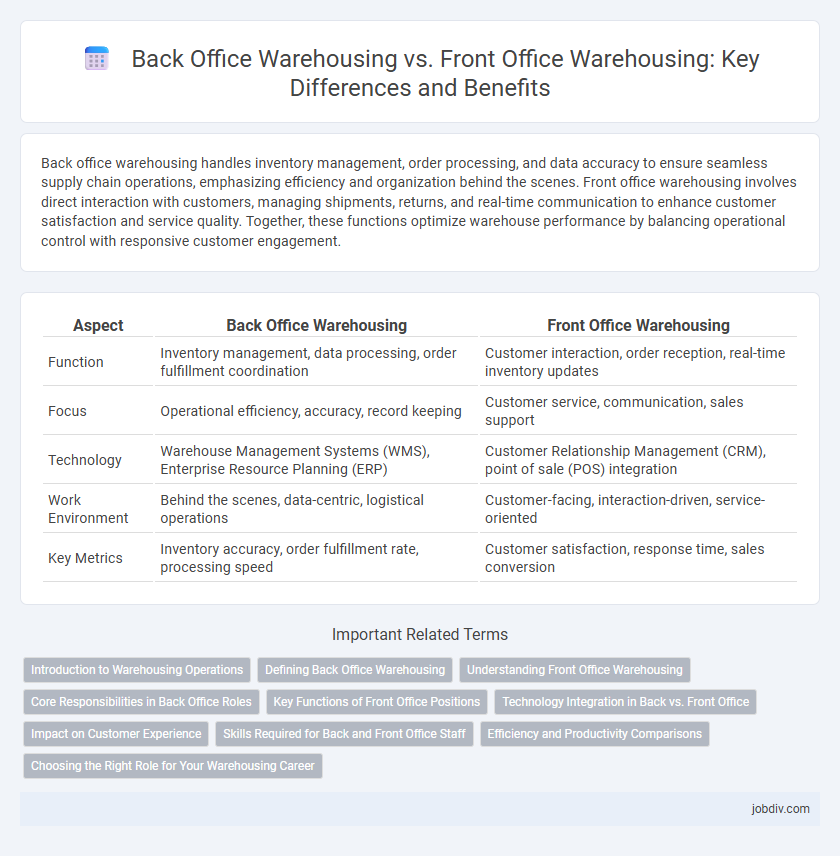Back office warehousing handles inventory management, order processing, and data accuracy to ensure seamless supply chain operations, emphasizing efficiency and organization behind the scenes. Front office warehousing involves direct interaction with customers, managing shipments, returns, and real-time communication to enhance customer satisfaction and service quality. Together, these functions optimize warehouse performance by balancing operational control with responsive customer engagement.
Table of Comparison
| Aspect | Back Office Warehousing | Front Office Warehousing |
|---|---|---|
| Function | Inventory management, data processing, order fulfillment coordination | Customer interaction, order reception, real-time inventory updates |
| Focus | Operational efficiency, accuracy, record keeping | Customer service, communication, sales support |
| Technology | Warehouse Management Systems (WMS), Enterprise Resource Planning (ERP) | Customer Relationship Management (CRM), point of sale (POS) integration |
| Work Environment | Behind the scenes, data-centric, logistical operations | Customer-facing, interaction-driven, service-oriented |
| Key Metrics | Inventory accuracy, order fulfillment rate, processing speed | Customer satisfaction, response time, sales conversion |
Introduction to Warehousing Operations
Back office warehousing involves inventory management, data processing, order verification, and logistics planning that support seamless warehouse operations behind the scenes. Front office warehousing focuses on direct interactions with customers and suppliers, including receiving shipments, picking and packing orders, and handling returns. Efficient coordination between both areas ensures streamlined warehousing operations, optimized stock control, and enhanced supply chain performance.
Defining Back Office Warehousing
Back Office Warehousing involves critical back-end operations such as inventory management, order processing, and data entry that ensure seamless warehouse functionality. It primarily focuses on internal processes including stock reconciliation, demand forecasting, and supply chain coordination to optimize inventory flow. These tasks support Front Office Warehousing activities by maintaining accurate records and facilitating efficient warehouse logistics.
Understanding Front Office Warehousing
Front Office Warehousing centers on direct customer interaction, managing inventory visibility, order processing, and real-time communication with clients to ensure accurate fulfillment. This approach integrates advanced warehouse management systems (WMS) that support seamless front-end operations such as picking, packing, and shipping, enhancing responsiveness and customer satisfaction. Efficient front office warehousing improves transparency and agility in supply chain management by aligning warehouse activities with demand forecasts and order tracking.
Core Responsibilities in Back Office Roles
Back office warehousing focuses on inventory management, order processing, and data entry to ensure accurate stock levels and seamless supply chain coordination. These roles handle documentation, inventory audits, and coordinate with suppliers to optimize stock replenishment and reduce discrepancies. Emphasizing accuracy and efficiency, back office tasks support front office operations by providing reliable inventory data and order fulfillment status.
Key Functions of Front Office Positions
Front office warehousing roles primarily involve direct interactions with external stakeholders such as suppliers, customers, and logistics partners, focusing on order processing, inventory inquiries, and shipment scheduling. These positions handle real-time communication, ensuring accurate data entry, coordination of inbound and outbound deliveries, and immediate problem resolution. Key functions include managing customer relationships, tracking goods movement, and facilitating efficient warehouse operations through technological tools like warehouse management systems (WMS).
Technology Integration in Back vs. Front Office
Back office warehousing leverages advanced warehouse management systems (WMS) and automated inventory tracking technologies to optimize storage, order processing, and supply chain analytics. Front office warehousing integrates customer-facing technologies such as real-time shipment tracking, digital kiosks, and responsive CRM platforms to enhance client communication and service efficiency. The synergy between sophisticated back office tech and interactive front office tools drives overall operational excellence in warehousing environments.
Impact on Customer Experience
Back office warehousing ensures accurate inventory management, timely order processing, and efficient logistics, directly influencing order fulfillment speed and accuracy. Front office warehousing engages with customers through real-time inventory visibility and responsive communication, enhancing transparency and trust. Together, these functions optimize the overall customer experience by reducing delays, minimizing errors, and providing seamless service interactions.
Skills Required for Back and Front Office Staff
Back office warehousing staff require strong analytical skills, proficiency in inventory management systems, and attention to detail to accurately process orders, update databases, and handle logistics coordination. Front office warehousing roles demand excellent communication abilities, customer service expertise, and problem-solving skills to manage client inquiries, facilitate deliveries, and ensure smooth operational flow. Both roles benefit from familiarity with warehouse management software and an understanding of supply chain processes to enhance overall efficiency.
Efficiency and Productivity Comparisons
Back office warehousing, focused on inventory management, order processing, and data analysis, enhances efficiency by streamlining internal operations and reducing errors. Front office warehousing emphasizes customer interaction, real-time order fulfillment, and responsive service, driving productivity through faster turnaround and improved client satisfaction. Comparing both, back office systems optimize workflow accuracy, while front office solutions accelerate order delivery and enhance overall operational agility.
Choosing the Right Role for Your Warehousing Career
Back office warehousing focuses on inventory management, data analysis, and supply chain coordination, requiring strong organizational and technical skills. Front office warehousing emphasizes direct interaction with logistics teams, customer service, and handling shipments, demanding communication prowess and operational oversight. Choosing between these roles depends on your strengths in either data-driven problem-solving or hands-on, real-time operational management within the warehousing industry.
Back Office Warehousing vs Front Office Warehousing Infographic

 jobdiv.com
jobdiv.com